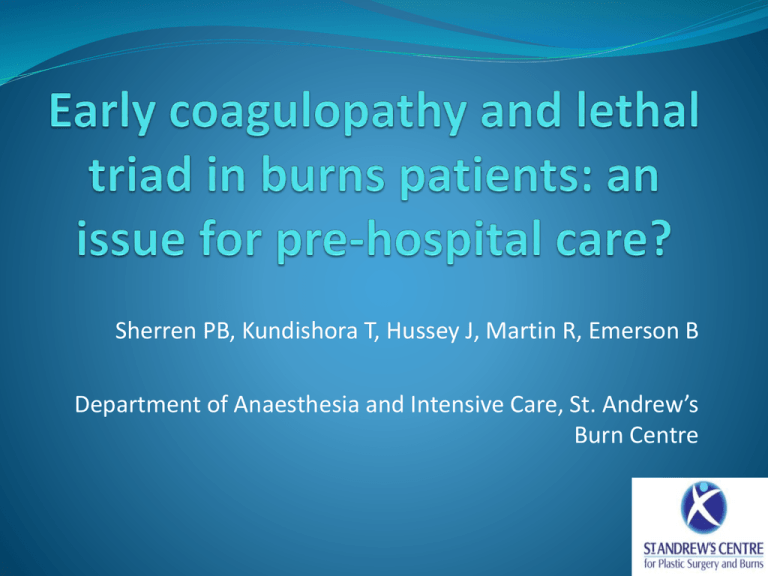
Sherren PB, Kundishora T, Hussey J, Martin R, Emerson B
Department of Anaesthesia and Intensive Care, St. Andrew’s
Burn Centre
The lethal triad
The ‘lethal triad’ is a well described entity in the trauma
population and is associated with significant mortality.
Moore EE. Am J Surg 1996;172:405-410
Major burn patients are exposed to similar physiological
insults
Little is known about the incidence and effect of an early
coagulopathy and lethal triad in burns patients
A lethal triad could impact on early surgical procedures,
CVS stability and septic complications
Coagulopathy
Acute traumatic coagulopathy (ATC) is a well
described phenomenon in the trauma population
associated with significant mortality Brohi K et al. J Trauma.
2003;54:1127-1130
ATC is an impairment of haemostasis involving a
complex dynamic interaction between endogenous
anticoagulants and fibrinolysis
ATC is driven by an endothelial injury and
hypoperfusion, which results in in increased
thrombomodulin expression and APC
An early burn induced coagulopathy has yet to be
demonstrated
Hypothermia
Significant problem!
Factors involved
• Large volume fluid resuscitation
• Thermal tissue injury impairs skin’s insulating ability
• Anaesthesia impacts thermoregulation
• Impaired endogenous heat production as a result of
anaerobic metabolism
• Reluctance to warm burn patients by medical
professionals?
Acidaemia
Major burns are characterised by
• Direct endothelial injury
• Systemic hypoperfusion
• Hypovolaemia/ haemoconcentration
• Impaired myocardial contractility and cellular
hypoperfusion.
This decreased oxygen delivery results in a shift to
anaerobic metabolism, lactate production and metabolic
acidaemia
The initial lactate is a strong predictor of mortality in
burns patients. Latenser BA. Crit Care Med. 2009 Oct;37(10):2819-26
Aim
The primary aim of this study was to identify a clinically
significant early burn induced coaguloapthy and lethal
triad in thermal injuries
We also sought any association with the validated
abbreviated burn severity index (ABSI), fluid
administration and mortality
Abbreviated Burn Severity Index
Methods
Patients with TBSA burns ≥30% from October 2008 to
December 2011 were identified from the metavision
database
A structured and anonymous metavision review was
conducted
The database was scrutinised for a predetermined list of
demographics, interventions, admission observations and
investigations
Exclusion criteria were: associated major trauma, arrival
at the burn centre>12 hours after burn, significant
CO/Cyanide poisoning, pre-existing coagulopathy, any
PRBC/FFP/PCC administration and non-thermal injuries
Definitions
Coagulopathy - PT≥14.7/APTT≥45 seconds
(Local lab. reference & Davenport et al. Crit Care Med 2011;39(12):26522658)
Hypothermia - Temperature≤35.5°C
Acidaemia - pH≤7.25
Lethal Triad
total cases reviewed
(n=205)
excluded
(n=60)
missing data
(n=28)
Lethal triad
Non Triad group
(n=15)
(n=102)
Demographics
Lethal Triad
P-value
Present (n=15)
Absent (n=102)
Age in years, mean (SD)
Sex (M/F)
TBSA burn, mean (SD)
Inhalational injury present
Abbreviated burn severity index,
median (IQR)
46 (20.9)
10/5
59.2 (18.7)
13 (86.7%)
12 (9-13)
33.0 (21.9)
65/37
47.9 (18.1)
31 (30.4%)
8.5 (6-10)
0.033*
1
0.027*
<0.0001*
0.0011*
Time from burn to arrival Burn
Centre in minutes, mean (SD)
352 (107.5)
361.5 (160.8)
0.83
Fluid received prior to arrival at
Burns centre. ml, mean (SD)
4783.3 (2140.1)
4167.1 (2910.6)
0.43
Fluid deficit according to Parkland
formula on arrival in Burns centre.
ml, mean (SD)
1903.2 (2095.6)
301.7 (2287.5)
0.012*
10/15 (66.7)
12/102 (11.8)
<0.0001*
Mortality rate at 28 days (%)
Coagulopathy
39.3% of the 117 patients were coagulopathic on
admission
There was no significant correlation between the PT and
volume of fluid administered (p - 0.095, r - 0.155)
The 28 day mortality rate for patients with a
coagulopathy of 39.1% was significantly higher than the
8.5% of those with normal coagulation (p-0.0001)
The predictive value of an early coagulopathy in regards
to 28 day mortality was sought using logistic regression
analysis. All components of the ABSI were adjusted for
An earlier coagulopathy was an independent predictor of
28 day mortality, OR 3.42 (1.11-10.56)
Incidence of coagulopathy with ABSI
Pearson product moment correlation coefficient r - 0.292 and p - 0.0013
100
90
80
70
Percentage
with
coagulopathy
60
50
40
30
20
10
0
≤7
8 to 9
10 to 11
ABSI
12 to 13
≥ 14
PT vs serum lactate
Pearson product moment correlation coefficient, r - 0.292 and p - 0.001
8
7
6
5
Serum Lactate 4
(mmol/L)
3
2
1
0
0
5
10
15
20
25
Prothrombin Time (seconds)
30
35
Summary
In patients with major thermal injuries there is a
clinically significant early burn induced coagulopathy
This coagulopathy correlates to serum lactate and
ABSI but is unrelated to fluid administration
An earlier coagulopathy was an independent
predictor of 28 day mortality
A subgroup of major burns patients exhibit the lethal
triad which is associated with an increased mortality
Conclusion
In the pre-hospital management of major burns it is
vital to accurately assess the burn area and
resuscitate appropriately to limit tissue
hypoperfusion
An acute burn induced coagulopathy has significant
bleeding implications for any surgical procedures
Ensure temperature conservation
• Highest possible ambient temperature
• Use of Clingfilm, space blankets and layering techniques
• Use of active warming methods such as heat pads and the
En-Flow fluid warmer
Questions?








